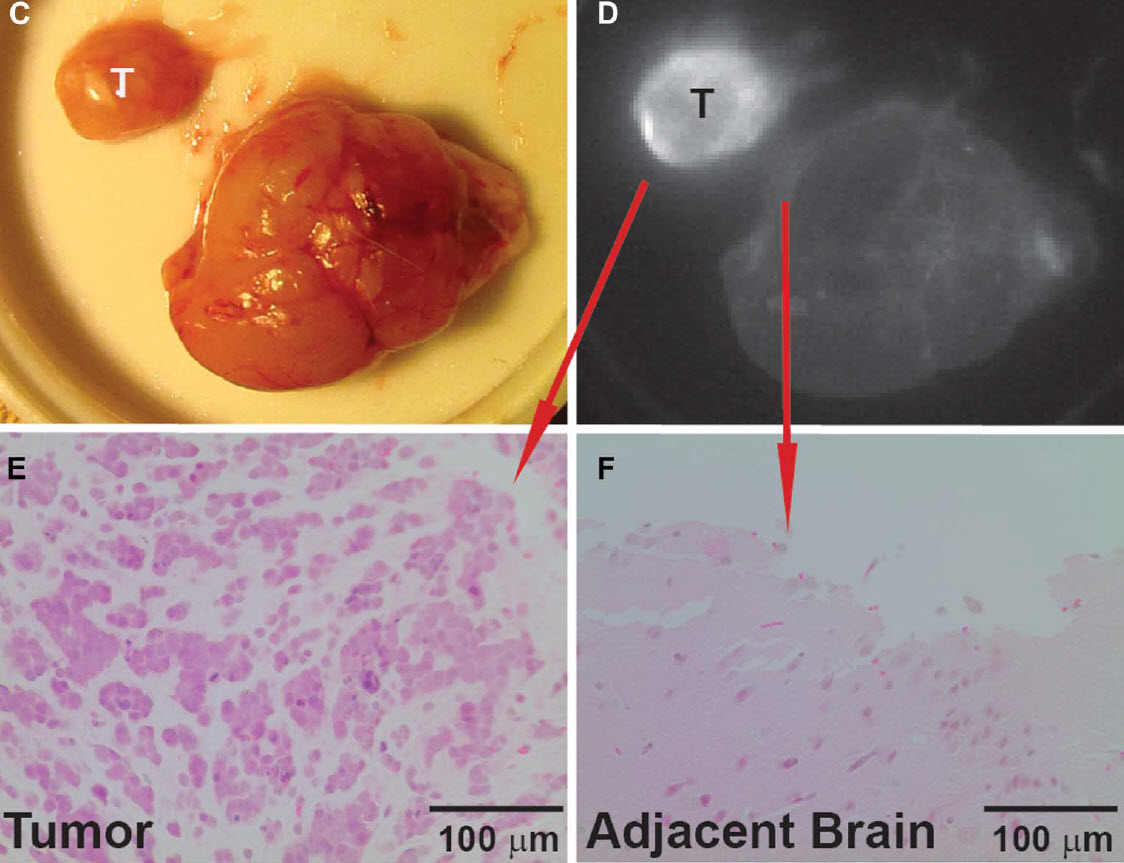Fluorescent dyes ‘light up’ brain cancer cells
February 4, 2015

CLR1502 near-infrared fluorescence of xenograft demonstrating (D) excellent macroscopic tumor (T) delineation from normal brain tissue compared with visible light (C). Histology: E: verification of tumor. F: normal brain. (Credit: Kyle I. Swanson et al./Neurosurgery)
Two new fluorescent dyes attracted to cancer cells differentiate brain tumors from normal brain tissue in mice, and may help neurosurgeons more accurately localize and completely resect (remove) brain tumors, suggests an open-access study in the February issue of Neurosurgery.
The two “tumor-selective” fluorescent agents — called CLR1501 and CLR1502 — were molecularly altered to carry fluorescent dyes that glow under lights with specific wavelengths — green (CLR1501) or near-infrared (CLR1502) range.
Viewed under appropriate conditions, the dyes make tumor cells “light up” so that they can be readily distinguished from neighboring normal brain tissue.
Using different types of imaging technologies, John S. Kuo, M.D., and colleagues evaluated the ability of CLR1501 and CLR1502 to detect implanted (xenograft) tumors in mice.
The results were compared with imaging studies performed with a dye called 5-aminolevulinic acid (5-ALA), which glows under blue light. Although 5-ALA is used for fluorescence-guided neurosurgery in Europe, it is not yet approved for routine use in the United States.
The results showed that CLR1501 and CLR1502 were attracted to tumor cells, and emitted light of specific wavelengths under appropriate imaging conditions. Imaging with CLR1501 green dye showed fluorescence similar to that achieved with currently used 5-ALA dye. With the near-infrared CLR1502 dye, fluorescence was even greater than with 5-ALA. The use of near-infrared fluorescence would offer additional advantages during actual surgery, compared to fluorescence in the visible-light range.
In preliminary studies, near-infrared imaging with CLR1502 successfully localized brain tumors through the intact skin and skull of living mice. In addition to fluorescent-guided neurosurgery, APC analogs might play useful roles in diagnosing brain cancers and in targeting chemotherapy drugs directly to cancer cells.
The researchers acknowledge the “inherent limitations” of their experiments, limited to implanted tumors in animals. Further research will be needed to assess issues related to dye administration, visualization, and timing, as well as the optimal technologies for practical use during surgery. “[U]pcoming clinical trials in human tumors are planned for these promising tumor-selective fluorescence agents,” Kuo and coauthors write.
Abstract of Fluorescent cancer-selective alkylphosphocholine analogs for intraoperative glioma detection
BACKGROUND: 5-Aminolevulinic acid (5-ALA)-induced tumor fluorescence aids brain tumor resections but is not approved for routine use in the United States. We developed and describe testing of 2 novel fluorescent, cancer-selective alkylphosphocholine analogs, CLR1501 (green) and CLR1502 (near infrared), in a proof-of-principle study for fluorescence-guided glioma surgery.
OBJECTIVE: To demonstrate that CLR1501 and CLR1502 are cancer cell-selective fluorescence agents in glioblastoma models and to compare tumor-to-normal brain (T:N) fluorescence ratios with 5-ALA.
METHODS: CLR1501, CLR1502, and 5-ALA were administered to mice with magnetic resonance imaging-verified orthotopic U251 glioblastoma multiforme- and glioblastoma stem cell-derived xenografts. Harvested brains were imaged with confocal microscopy (CLR1501), the IVIS Spectrum imaging system (CLR1501, CLR1502, and 5-ALA), or the Fluobeam near-infrared fluorescence imaging system (CLR1502). Imaging and quantitative analysis of T:N fluorescence ratios were performed.
RESULTS: Excitation/emission peaks are 500/517 nm for CLR1501 and 760/778 nm for CLR1502. The observed T:N ratio for CLR1502 (9.28 ± 1.08) was significantly higher (P < .01) than for CLR1501 (3.51 ± 0.44 on confocal imaging; 7.23 ± 1.63 on IVIS imaging) and 5-ALA (4.81 ± 0.92). Near-infrared Fluobeam CLR1502 imaging in a mouse xenograft model demonstrated high- contrast tumor visualization compatible with surgical applications.
CONCLUSION: CLR1501 (green) and CLR1502 (near infrared) are novel tumor-selective fluorescent agents for discriminating tumor from normal brain. CLR1501 exhibits a tumor-to-brain fluorescence ratio similar to that of 5-ALA, whereas CLR1502 has a superior tumor-to-brain fluorescence ratio. This study demonstrates the potential use of CLR1501 and CLR1502 in fluorescence-guided tumor surgery.